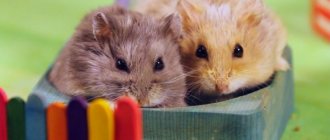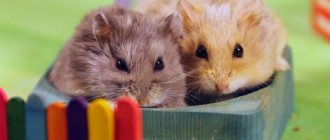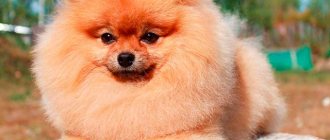- home
- Kinds
01.11.2018 Pets add variety to life and bring joy to children. The dwarf hamster does not take up much space in the house and is undemanding in care. It is enough to get to know the character of the rodent better, understand the principles of caring for it, and an entertaining miniature hamster will bring only pleasant emotions.
Varieties of dwarf hamsters
Proper handling and maintenance of dwarf hamsters requires knowledge of the characteristics and habits of each representative of this species.
The length of these animals does not exceed 50–70 mm, the average weight is 45 grams, and their life expectancy is about two years. Gentle pets need a caring attitude, but they are absolutely not problematic in terms of care and maintenance.
The most common representative is the Djungarian hamster, most often gray-brown in color, with a black stripe on the back. Taylor's dwarf hamsters are very similar to mice. The Campbell's hamster has a beautiful brown coat and a cheerful disposition. The Roborovsky hamster has a magnificent color, the fur on its back and head has a stunning sandy-golden hue, and its belly is white.
Each representative of dwarf hamsters has its own characteristics, but they are united by hyperactivity. This is a distinctive feature from its larger counterparts.
Djungarian hamster
Djungarians are funny rodents no more than 100 mm long and weighing up to 50 g. The animal has nice thick short fur. In nature, dzhungarikas have a gray-brown back with a bright black “ribbon” in the middle. The belly is always lighter, and the paws are white on the inside. Expressive eyes are black, convex and shiny, the muzzle is white.
Over the course of many years of selection of dwarfs with unusual deviations in color, the nurseries bred animals of interesting colors:
- tangerine almost red, but with the same stripe along the back;
- gray-blue, or sapphire;
- pearl without a characteristic stripe.
Dzungarik with a natural color is more resistant to disease. An animal with a mutation, an unusual color, very gentle and requires special care.
Red, or as they are also called, tangerine hamsters should not have joint offspring in order to avoid the birth of non-viable cubs.
At what age can children be separated from their mother?
If the female has problems with feeding, the owner can help. This task is not for busy people, because babies need food every hour and a half. For such purposes, soy-based infant formula marked 0+ is ideal. You can use Royal Canin cat milk replacer.
Each baby needs an individual approach; it needs to be soldered using a pipette or a syringe with a non-sharp end. A pharmacist will help you choose the right option. To prevent the baby from choking, it is kept in an upright position, and liquid is poured in small portions. For better absorption, you can massage your abdomen in a circular motion for a couple of minutes. For greater health, it is worth monitoring the animal’s stool and keeping it warm.
It’s sad, but if the mother has health problems, then most of the cubs die, even with high-quality and timely care from the owner. Such milk will not provide all the nutrients that mother's milk contains. Pneumonia may also occur due to fluid entering the respiratory tract, as well as infectious diseases due to weakened immunity.
A foster nursing mother is an amazing thing to come!
Sometimes breeders manage to save offspring with the help of an adoptive mother. She can become a female who has recently given birth to a large offspring and has good milk. For a mixture of cubs with the offspring of the foster mother, you can roll them in the toilet corner and throw them to the female at 1-3 weeks of age.
During the artificial feeding procedure, the sooner children begin to feed on their own, the better. You can get used to natural nutrition by mixing food into the milk mixture.
Taylor's Hamster
Taylor's dwarf hamster does not grow more than 80 mm. Because of its nice elongated muzzle and elongated body, it resembles a funny mouse. Beady eyes and tiny ears complete the fabulous picture.
The fur is fluffy and soft, the color is brownish-brown, the belly is white, and there is an elegant dark stripe on top.
Hamster lovers immediately buy a pair, and the animals get along well and breed. After 20 days of pregnancy, the female gives birth to three or even five cubs. She can have 10 offspring in a year.
In addition to its body structure, Taylor's hamster has another similarity with mice: the female and male tenderly care for their offspring.
Campbell's hamster
The Campbell's hamster was once classified as a subspecies of the Dzungarik, but at the beginning of the 20th century it received its separate name from the British consul Charles Campbell, who brought amazing animals from the Russian-Chinese border.
Animals of both species are very similar to each other, but there are also significant differences:
- Campbells have slightly tousled fur, compared to the smooth, combed Djungarians;
- Campbells do not change color in winter, unlike dwarfs;
- the body has a “waist”, jungariki are egg-shaped.
Campbell's hamsters can be colored in the following colors: agouti, albino, opal, argenta, black, fawn, dove, blue, chocolate, lilac, blue spotted beige, platinum.
The main sign that this is a Campbell: unlike the friendly Djungarian, he does not like to sit on his hands and tries in every possible way to demonstrate his own independence. This is probably why Consul Charles Taylor liked the animal.
Syrian
The second most popular species is the Syrian hamster. This species is medium-sized and much larger: the body length is considered to be 12 cm, but there are individuals up to 20 cm tall (this is the largest hamster among pets). The usual color is golden (reddish, peach). Often, for marketing purposes, sellers call this breed Royal, and the name Yellow Hamster is found. Many consider it the most beautiful breed.
There are simply countless decorative colors obtained as a result of selection. The Syrian can be of almost any color, as well as multi-colored.
The character is a little more absurd than that of the Djungarians, but you can tame the Syrian. Females are angrier than males, so we recommend boys for solitary housing. If you are planning to get several Syrian animals, house them separately, even in pairs (only house them for the duration of mating).
They live 3-4 years; long-livers have been known to live up to 5 years.
We have outlined everything you need to know about the maintenance and nutrition of the Syrian breed in this article.
Angora hamster
There is no breed of Angora hamster. This is often the name given to Syrians who are extremely shaggy and have long hair (up to 10 cm). Decorative breed, famous for its fluffiness. The coat requires additional care - keep this in mind if you are planning to get a shaggy hamster.
Golden hamster
Naturally colored Syrians are most often called golden, but there are also representatives of other breeds of this color (for example, tangerine dzhungarik).
Roborovsky's hamster
Roborovsky's hamsters are named after the Russian scientist who discovered and first described them. The homeland of the animal is China and Mongolia. But they are also found in Russia, for example, in the foothills of the Tien Shan.
Gradually, this animal won the hearts of lovers of miniature hamsters.
It is distinguished by its characteristic “bleached” eyebrows and fur-lined paw soles. Their eyes are always black. The color is most often a chic platinum color. There are variegated, snow-white, agouti, and cinnamon colors. In the wild, Roborov hamsters turn white in winter.
Breeders are attracted by the animal's high immunity to diseases. This is a distinctive feature of the Roborovsky hamster from its brothers.
Need to know before buying
If you want your hamster to live a long and happy life, it is important to follow a few rules:
- They quickly get used to the hands, but also quickly lose the habit. Play with them, squeeze them, in general, don’t just keep them in an aquarium, where they quickly become wild, to the point that at the sight of a human hand they will rush at it and bite until they bleed;
- This is a genus of “family” animal, meaning it must have a mate of the opposite sex. Of course, a hamster can live alone, but this is wrong. Moreover, when paired, they will never go wild again; in any case, it will not come to the point of biting.
Preparing a home for hamsters
You should also take care of housing for rodents in advance. The Djungarian hamster does not require care in such large sizes as, for example, cats, but still.
Both cages and spacious aquariums are suitable for housing. But it is worth noting that they are not that stupid. A couple of months of watching you open the door and one morning you find an empty cage.
A paradise for your pet
Although if there are tall buildings in the aquarium, they can easily jump over the edge. If this happened in your absence, then there are two scenarios:
- Look for animals under furniture that have low legs. They try to avoid open spaces; for their instinct there are more dangers there. Rodents are very fond of paper and cardboard - if you have books hidden under your bed, you will most likely find them there;
- The second option is much simpler and faster - just turn off the lights and freeze. In a maximum of five minutes you will hear the rustling and clicking of claws. A couple more moments, and they will begin to run out onto the open surface - then you catch them. Don't worry, they won't get a heart attack from fright.
Let's go back to their house. The floor should be completely covered with sawdust; this is a general rule for all rodents. If sawdust cannot be used, we use paper, but sawdust is more preferable. Hamsters will then make nests from them and breed offspring.
The next important rule is that they must have a shelter, either a small house or a clay cave, which can be purchased at a pet store.
Animal houses
They can hide there if they are in a bad mood, and just sleep during the day so that the light does not interfere.
And the last thing on the housing issue - be sure to install playgrounds, hamsters are very active animals. Stairs, a running wheel, rope bridges, etc. are a must. This will make the hamster’s life much more fun, this is important for a caring owner.
A real gym for a hamster
If you are ready to follow these rules, then you can go to the pet store to make a purchase.
Care and choice of housing
The animals are extremely active, they need a large cage. You need to pay attention to the distance between the rods, which should not be more than 0.7 cm, otherwise the animal will run away.
Additionally, a running wheel, a small house for sleeping, labyrinths, and a sand bath are purchased.
Large sawdust or shavings are needed as filler, without dust, otherwise it will clog the animal’s airways. Do not use newspapers, as printing ink is poisonous to the hamster.
Hamsters are very clean. There is no need to bathe them, they will take care of themselves. But you need to clean the toilet as often as possible, otherwise an unpleasant odor will appear, and this is stressful for the pet.
It is very useful to let your hamster walk in a special walking ball. 15–20 minutes a day is enough to make a restless animal feel happy.
Today you can see two-level cages for hamsters on sale. Rodents, curious and nimble by nature, will definitely climb to the second floor. And then - depending on your luck. If they fall, there will be a tragedy. This must be taken into account when choosing a home for a miniature, delicate animal.
What to feed
Dwarfs have a high metabolism (metabolism), so they need more calories per gram of weight than their full-sized counterparts.
It is believed that the daily food intake is a tablespoon of grain feed. In any case, it is better to focus on the spot: each organism is an individual, the main thing is not to overfeed and avoid obesity. They feed twice a day.
Insects and twisted boiled meat (beef or chicken) are served as delicacies. The presence of animal protein in the diet of animals during pregnancy and feeding of offspring is especially important.
Don’t forget about liquid, which is necessary for any organism: the drinking bowl should always be filled with clean water at room temperature.
Hamsters' teeth are constantly growing, so it is vital for rodents to sharpen them. To prevent the baby from gnawing everything, a chalk stone, twigs, or even dog treats are placed in the cage. Neither has a negative effect on the dental or digestive system.
Composition and nutritional standards
The dwarf hamster is an omnivore. But there is no need to abuse this quality to the detriment of the rodent and feed it everything that a person has on the table.
The basis of the menu for hamsters is seeds, cereals, greens, fruits and vegetables. Hamsters develop activity and appetite, so it is better at this time.
In the morning, it is enough to give him pieces of fruit, vegetables, corn, peas, and a dandelion leaf. In the evening, the diet can be supplemented with fish, chicken breast, cooked without salt and spices.
Your hamster should always have water. Remove spoiled food promptly, otherwise the animal will be poisoned. The animal should always have grains in its bowl, otherwise it will think that the cold weather is coming and it’s time to stock up for the winter.
You cannot offer your hamster citrus fruits, pomegranate, kiwi, cookies and candies, chocolate, watermelons, cabbage, milk, sausage, chips, hot crackers and other foods that will quickly damage the rodent’s gastrointestinal tract.
Possible diseases
Dwarf hamsters may have the following diseases:
- conjunctivitis, when the eyes fester, the eyelids stick together;
- diarrhea due to poor diet;
- damage to the cheek pouches from spicy food;
- bite wounds;
- worms;
- improperly growing teeth due to the fact that hamsters are not provided with crackers and twigs for grinding them down;
- cystitis from infection or drafts;
- scabies, which is usually caused by the scabies mite.
For any diseases, you should not treat your hamster with “folk remedies”, but immediately show it to a veterinarian.
When caring for dwarf hamsters, you need to follow this principle: the less stress he has, the longer he will live. You need to train yourself not to raise your voice in the presence of a hamster, not to make sudden movements. Ultimately, you will prolong the life of not only your pet, but also yourself.
Source
Features of reproduction
In order for the couple to be successful and fertile, hamsters are accustomed to each other from an early age. If you plan to breed hamsters, it is advisable to immediately take a pair. There is no need to experiment with different subspecies. Only cubs born from Dzungariks and Campbells are viable.
In captivity, rodents can bear offspring all year round. As soon as the female turns four months old, she is ready to bear offspring. An earlier pregnancy is undesirable; it can have a bad effect on the mother’s well-being. The female carries the cubs for 20 days. One litter can have up to 12 newborns.
The female needs to create favorable conditions. First of all, this is a diet rich in protein foods; in addition, buy a complex of vitamins. Before giving birth, you need to remove the male. Remove labyrinths and simulators, add more sawdust. The female will make a good nest for herself.
Bald, blind and deaf hamsters will acquire a “beautiful” appearance in just a week. After 15 days they will be feeding themselves. After 25–30 days, the cubs need to be “sorted” by gender and placed in cages.
You cannot pick up babies. The female may become angry, react aggressively to someone else's scent and show a tendency towards cannibalism. If the hamster falls out, it is picked up with a spoon, which is first dipped in the bedding.











